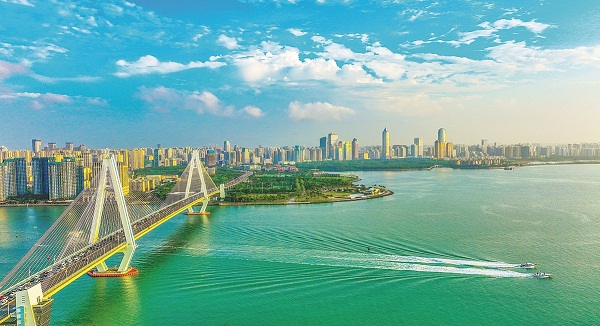
A panoramic view of the Century Bridge spanning the sea in Haikou, Hainan. [Photo by ZHANG MAO/FOR CHINA DAILY]
Pilot project attracts overseas enterprises, places island at forefront of opening-up efforts
The second China International Consumer Products Expo, which ended on July 30 in Haikou, Hainan province, attracted more than 280,000 visitors and about 2,800 brands from home and abroad.
Like the first expo, the second successfully highlighted China's consumption power on the global stage and laid out fresh opportunities to diversify domestic market channels.
It also further encouraged global luxury groups to continue exploiting opportunities presented by the Hainan Free Trade Port, which is helping develop not only the region, but also the rest of the world, organizers and experts said.
The tropical island of Hainan, China's southernmost province, has been at the forefront of the country's opening-up drive, especially since the launch of the Hainan FTP in June 2020, when China unveiled a master plan to develop the island into a free trade port with Chinese characteristics and global influence by the middle of the century.
"Looking back at the past 10 years, the main theme behind Hainan's development has been comprehensively deepening reform and opening-up, and the primary highlight is the construction of the Hainan Free Trade Port," Shen Xiaoming, secretary of the Hainan Provincial Committee of the Communist Party of China, said at a recent news conference in Haikou, the provincial capital, while discussing the province's socioeconomic achievements.
Building the Hainan FTP is a major national strategy that has been planned, deployed and promoted by President Xi Jinping, with the goals of making Hainan a paradigm of reform and opening-up in the new era of China's development and building a community with a shared future for humankind, government officials said.
Hainan, a node connecting China with Southeast Asia, is hastening to ensure high-quality development and make the Hainan FTP a model for China's reform and opening-up policy in the new era, said Shen, the top provincial official.
He said the implementation of the Hainan Free Trade Port Law and more than 180 policies since 2018 have together established a free trade port system that is characterized by "zero tariffs, a low tax rate and a simple tax system" and promotes the free and convenient flow of trade, investment, cross-border capital and personnel, as well as the safe and orderly flow of data.
Hainan has completed 123 institutional integration innovations in fields such as commercial registration, foreign investment management and trade supervision. The significant headway made has facilitated a more open, convenient and efficient business environment for traders and investors, local officials said.
Last year, the policy incentives and institutional innovations prompted Hainan's economy to grow by 11.2 percent year-on-year, the highest growth rate among all provincial regions in China, while its annual GDP rose from 285.5 billion ($42.3 billion) in 2012 to 647.5 billion, according to data from the provincial government. By June, registered business entities had jumped to 1.98 million, from 420,000 in 2012, the data showed.
Shen Danyang, executive vice-governor of Hainan, said that the Hainan FTP has become a strong magnet for foreign investment as the province accelerates its opening-up against the backdrop of the global economic slowdown caused by the COVID-19 pandemic. He said 1,936 foreign-invested enterprises were established last year in Hainan, an increase of 92.64 percent over the previous year.
Its foreign trade has more than doubled from 70.28 billion yuan in 2017 to 147.68 billion yuan last year. Foreign direct investment has hit $8.81 billion over the past four years, with an average annual growth rate of 79.4 percent.
A growing number of foreign companies are settling in Hainan, including electric automaker Tesla and Tapestry Group from the United States, German tourism service provider TUI Group and Canadian candy maker Green Chocolate Works.
Lured by the new offshore duty-free policies updated by the central authorities in 2020, about 30 overseas luxury and beauty brands selling goods such as clothing, jewelry and makeup have opened boutiques so far this year in Hainan, which is building itself into an international tourism consumption destination, local authorities said.
Industry experts estimate that the market value of offshore duty-free products in Hainan is likely to exceed 160 billion yuan in 2025, making the island the largest offshore duty-free shopping market in the world.
Erik Juul-Mortensen, president of the Tax Free World Association, said in a video speech during the Haikou expo last month that at a time full of challenges for businesses, Hainan is the "lighthouse" for the global tax-free and travel retail industry.
Michael Straub, associate partner with McKinsey, said the upcoming major policy changes in the Hainan FTP will keep the island "a competitive travel and duty-free destination".
Meanwhile, exchanges in international energy, shipping, commodities and carbon trading have been established in the free trade port, which will be the largest in the world when construction is completed.
For a province that used to rely heavily on the real estate sector, Hainan has highlighted the implementation of the new development philosophy as the fundamental catalyst for growth, especially the promotion of a modern industrial system that focuses on the development of tourism, service, high-tech sectors and high-efficiency tropical agriculture, local officials said.
Feng Fei, governor of Hainan, said the province is making full preparations to launch island-wide customs clearance operations by 2025 as part of broader measures to promote trade and investment liberalization and facilitation, and to better integrate itself into the country's new development paradigm of domestic and international economic circulation, or "dual circulation".
Solid efforts have been made to promote the development of Hainan as a national ecological civilization pilot zone and ensure its unique environment is well-preserved.
Its air, water and soil quality remain excellent, while the annual average concentration of PM2.5 dropped to 13 micrograms per cubic meter last year, from 25 about 10 years ago, Feng said.